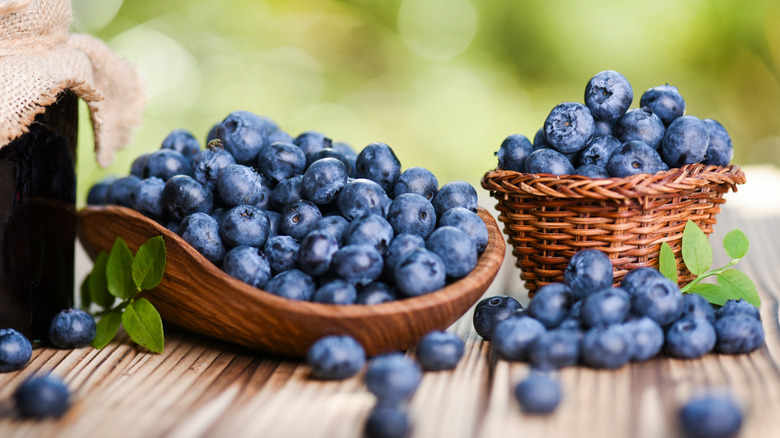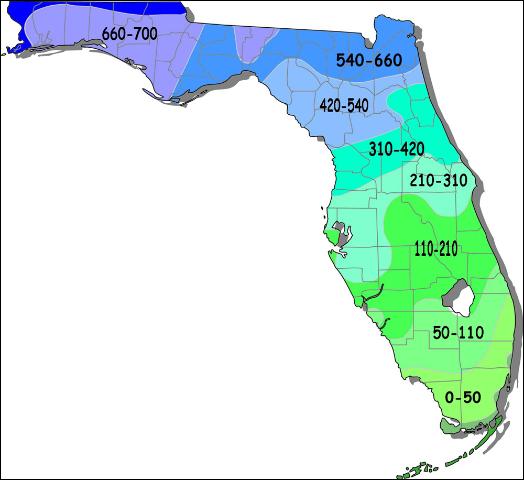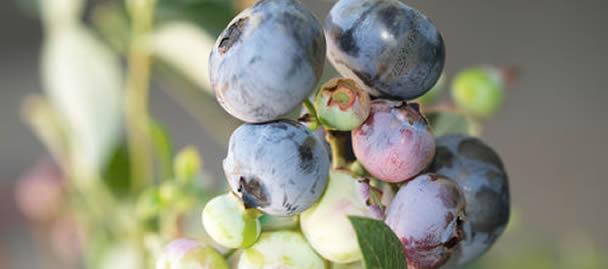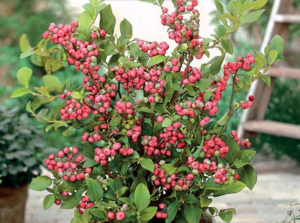How to Select Blueberry Varieties for Your Location
Have you ever had the pleasure of picking blueberries? Maybe you’ve grown your own or know someone else who grows them . U-Picks are also popular during blueberry season. Fresh, organic blueberries are a perfect blend of sweet and tart and they’re oh so juicy. That experience is sure to get you hooked on wanting to grow your own. There are actually many blueberry varieties that grow well in different regions. Before you go out and buy some blueberries bushes, I recommend doing a little bit of research beforehand. I’ll go over the basic bush varieties and what to look for when picking your plants and along with some common varieties.
Selecting the Right Blueberry Varieties
When selecting the right blueberry varieties you’ll want to take 4 things into consideration:
- USDA Hardiness Zone
- Chill Hours
- Plant Characteristics
- Harvesting Times
USDA Hardiness Zone & Chill Hours
Your hardiness zone and the number of chill hours your location receives will play a big factor, so it’s important you know what those numbers are. To learn more about your zone, check out this Hardiness Zone article. Chill hours are the number of hours that fall below 45 °F during the year. The Chill Hour Map below shows the chill hours for the cold season beginning September 1st, 2021. You can do some research for your specific area to see what the average chill hours are.
Credit: MRCC VIP Project
Blueberries need a certain number of chill hours (which varies among varieties) for proper growth. Blueberries that don’t receive enough might not have their flower buds open. And blueberry plants that require a low number of chill hours can be damaged up north where there are more chill hours.
Credit: UF/IFAS Extension – Florida Average Chill Hours Map
Plant Characteristics & Harvesting Times
Different blueberry cultivars have different characteristics such as flavor, firmness, foliage, and size. Another characteristic you’ll want to take into consideration is when you can harvest your blueberries. Different varieties can be harvested early, mid, or late season. To prolong your harvesting season you may want some of each (depending on the space you have).
There are 5 general types of blueberry bushes. From the order of cold to warm tolerant, they are – Lowbush, Half Highbush, Northern Highbush, Rabbiteye, and Southern Highbush. Highbush varieties are self-fertile, but cross-pollination can produce larger berries. Rabbiteye, on the other hand, need to be cross-pollinated with another rabbiteye variety.
Lowbush Blueberry Varieties
Occasionally you’ll hear someone refer to a cultivated dwarf blueberry as a lowbush variety. They’re probably more accurately called “dwarf blueberry.” Lowbush blueberries (vaccinium angustifolium and Vaccinium myrtilloides) are actually wild blueberries, and they’re typically found in Maine and Eastern Canada. They thrive in glacial soils and northern climates. And unlike our cultivated blueberry plants, wild blueberries are spread primarily by rhizomes (underground runners – similar to ginger).
Wild Blueberries are one of three berries native to North America. The other two are Concord grapes and cranberries, which have grown naturally for thousands of years. They also have more antioxidants than cultivated blueberries, are typically darker, and are smaller in size. They grow from 8 to 18″ tall in spreading mats. Here’s a picture of how wild blueberries look.
Hardiness Zone: 3-6
Half-High Blueberry Varieties
Half-High blueberries are a cross between highbush and lowbush varieties. These handle colder temperatures than most northern high bush varieties, being suitable for zone 3. They grow 3-4 feet tall and can be grown in containers. Half-highs are also self-fertile, but can still benefit from cross-pollination for better yields and larger fruit. They should be planted in the spring so roots become well established before winter.
Hardiness Zones: 3-7
Early Season Cultivars:
- Northland – USDA Zone: 3-7. Chill Hours Needed: 800-1000.
- Polaris – USDA Zone: 3-7. Chill Hours Needed: 800-1000.
Early Mid Season Cultivars:
- Northblue – USDA Zone: 3-7. Chill Hours Needed: 800-1000.
- Northcountry – USDA Zone: 3-7. Chill Hours Needed: 800-1000.
Mid Season Cultivars:
- Chippewa – USDA Zone: 3-8. Chill Hours Needed: 800-1000.
- Northsky – USDA Zone: 3-7. Chill Hours Needed: 800-1000.
- Top Hat: USDA Zone: 3-7. Chill Hours Needed: 1000+. *dwarf
Northern Highbush Blueberry Varieties
Northern Highbush varieties (Vaccinium corymbosum) are native to the eastern and northeast United States. They can grow from 2 to 6 feet tall. They’re self-fertile. Because of the size they can get, they need consistent pruning.
Hardiness Zones: 4-7
Early Season Cultivars:
- Blueray – USDA Zone: 4-7. Chill Hours Needed: 800+.
- Duke – USDA Zone: 4-7. Chill Hours Needed: 800-1000.
- Patriot – USDA Zone: 3-7. Chill Hours Needed: 1000+.
- Reka – USDA Zone: 4-7. Chill Hours Needed: 800-1000+.
Mid Season Cultivars:
- Bluecrop – USDA Zone: 4-7. Chill Hours Needed: 800+.
- Bluegold – USDA Zone: 4-8. Chill Hours Needed: 800+.
- Jersey – USDA Zone: 4-7. Chill Hours Needed: 800-1000.
- Toro – USDA Zone: 4-8. Chill Hours Needed: 800+.
Late Season Cultivars:
- Chandler – USDA Zone: 4-7. Chill Hours Needed: 1000+.
- Elliot – USDA Zone: 4-7. Chill Hours Needed: 800+.
- Legacy – USDA Zone: 4-8. Chill Hours Needed: 800.
Rabbiteye Blueberry Varieties
Rabbiteye blueberries (Vaccinium ashei) are native to the southeastern US and can grow 6-10 feet tall. They thrive in areas with long, hot summers, but still require some chill hours. They’re more susceptible to really cold winters compared to Northern Highbush varieties. They have thicker skins and more obvious seeds. They also need 2 different varieties of rabbiteye to cross-pollinate and fruit.
Hardiness Zones: 7-9
Mid Season Cultivars:
- Premier – USDA Zone: 7-9. Chill Hours Needed: 550.
Mid Late Season Cultivars:
- Climax – USDA Zone: 7-9 Chill Hours Needed: 400-450.
- Powderblue – USDA Zone: 7-9. Chill Hours Needed: 550-650.
- Tifblue – USDA Zone: 5-9. Chill Hours Needed: 600-700.
Late Season Cultivars:
- Brightwell – USDA Zone: 7-9. Chill Hours Needed: 350-400.
Southern Highbush Blueberry Varieties
Southern Highbush varieties are typically a hybrid of the northern highbush and native southern blueberries or rabbiteye blueberries. Different varieties can grow from 2 to 6 feet tall. This variety does best in the south, southwest, and west coast. These are best suited for central and south Florida. They are great for mild winters and require minimal amounts of chill hours to bud and flower. They blossom in late winter, and frost will damage flowers so you’ll want to cover them. Southern highbush are self-fertile, but produce better yields when cross-pollinated with other varieties. They should be planted between fall and spring so that the roots are more mature before the summer heat.
Hardiness Zones: 7-10
Early Season Cultivars:
- Colibri – USDA Zone: 8-10. Chill Hours Needed: 200.
- Misty – USDA Zone: 5-10. Chill Hours Needed: 300.
- O’neal – Hardiness Zones: 7-9. Chill Hours Needed: 200.
- Star – USDA Zone: 7-10. Chill Hours Needed: 400.
- Sharpblue – USDA Zone: 7-10. Chill Hours Needed: 200.
- Sunshine Blue – USDA Zone: 7-9. Chill Hours Needed: 150.
Mid Season Cultivars:
- Emerald – USDA Zone: 7-10. Chill Hours Required: 250.
- Jubilee – USDA: 5-9. Chill Hours Required: 400-500.
- Jewel – USDA Zone: 7-10. Chill Hours Required: 200.
- Biloxi – USDA Zone: 8-10. Chill Hours Required: 150.
Late Season Cultivars:
- Ozarkblue – Hardiness Zones: 5-9. Chill Hours Required: 800-1000.
- Southmoon- USDA Zone: 6-9. Chill Hours Needed: 200-300.
If there are any above that strike your fancy you can research more of the characteristics of them:
I’ve purchased blueberry bushes from Grow Organic. I’ve grown Emerald, Jewel, Misty, O’Neal, Sharpblue, and Sunshine Blue.
Read more:















